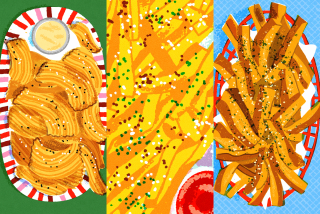Where Fries Are Already in the Burger : Livestock: Potato byproducts allow Idaho cattle ranchers to fatten their herds at cheaper cost.
- Share via
BOISE, Idaho — You can make fries with potatoes. You can make chips with potatoes. You can make pancakes with potatoes.
And in Idaho--the land of spuds--they have learned how to make something else with potatoes: hogs and cattle.
Idaho producers are feeding their livestock 3 million pounds of potato byproducts and wastes each day, as well as other non-traditional feeds. It cuts costs, fattens the herd and gladdens the potato industry.
“You don’t have to buy any french fries here when you get a hamburger,” Dan Hammond said. “The fries are already in the beef.”
Hammond, president of the Idaho Cattle Assn., manages a feedlot in American Falls for Boise-based Agri Beef. His 10,000 head munch about 225,000 pounds of spuds a day from the local Lamb Weston potato-processing plant.
Skins, slivers and short ends--as well as fries rejected for cosmetic reasons--are usually mixed with green chopped alfalfa and grain to make a carbohydrate-stuffed meal that puts weight on a herd quickly.
University of Idaho agricultural economist Neil Meyer said byproduct feed helps Idaho’s two largest commodities--potatoes and cattle--benefit economically from each other.
“Processors can’t just dump potatoes into the river or on the ground,” he said. “Cattle turn our waste product into meat.”
Potato byproducts cost less than $20 a ton compared to $120 a ton for standard dry feed. But hog farmer Dave Roper of Kimberly said potato-based feed has to be tempered so his fry-loving animals don’t stray from a balanced diet.
“They’re just like a kid--they’ll eat just the good stuff,” Roper said.
Idaho’s livestock growers are an experimental lot. While hogs across the nation are being fed corn and soybean meal, Idaho pigs feast on culled peas, barley, wheat and cooked dried beans as well.
Mark Boggess, swine and beef cattle specialist at the University of Idaho’s Twin Falls Extension Center, contrasted Idaho with his native Iowa, where a quarter of the nation’s hogs are raised.
“There’d be a random herd here and there where a farmer would take advantage of the situation, but less than one in a hundred use non-traditional feed,” he said.
But elsewhere, there is more enthusiasm for non-traditional feeds. Byproducts unique to one area or another are being used much as potatoes are used in Idaho--cottonseed cake and rice bran in the South, brewer’s grain in the Midwest, and orange peelings in Florida.
Potatoes provide calories at as little as half the cost of standard grains, said Patty Hagler, a nutritionist for Agri Beef.
“Other nutritionists are fascinated by this ‘new’ and ‘different’ ingredient we utilize,” she said.
Potatoes could be a boon to expanding Idaho’s beef exports overseas. Hagler said corn gives carcass fat a yellow tint while potatoes keep it white, a trait desired by the Japanese.
There are drawbacks. High-moisture potatoes shrink up to 50%, quickly rot and are tough to manage in cold snaps.
More to Read
Sign up for Essential California
The most important California stories and recommendations in your inbox every morning.
You may occasionally receive promotional content from the Los Angeles Times.











